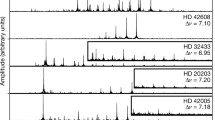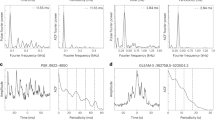Abstract
WE define a pulsar duty cycle, in the usual way, as the ratio of pulse width to the period of repetition of the pulse (Table 1). On the basis of some extremely simple physical assumptions we compute a histogram for distribution of pulsar duty cycles, and the distribution fits the observations reasonably well as shown in Fig. 1.
This is a preview of subscription content, access via your institution
Access options
Subscribe to this journal
Receive 51 print issues and online access
$199.00 per year
only $3.90 per issue
Buy this article
- Purchase on Springer Link
- Instant access to full article PDF
Prices may be subject to local taxes which are calculated during checkout
Similar content being viewed by others
References
Gold, T., Nature, 218, 731 (1968).
Large, M. I., Vaughan, A. E., and Wielebinski, R., Nature, 223, 1249 (1969).
Author information
Authors and Affiliations
Rights and permissions
About this article
Cite this article
HENRY, G., PAIK, HJ. Distribution of Pulsar Duty Cycles. Nature 224, 1188–1189 (1969). https://doi.org/10.1038/2241188a0
Received:
Revised:
Issue Date:
DOI: https://doi.org/10.1038/2241188a0
This article is cited by
-
Rate of stellar collapses in the Galaxy
Astrophysics and Space Science (1977)
-
Electrodynamics of pulsars
La Rivista del Nuovo Cimento (1970)
Comments
By submitting a comment you agree to abide by our Terms and Community Guidelines. If you find something abusive or that does not comply with our terms or guidelines please flag it as inappropriate.



